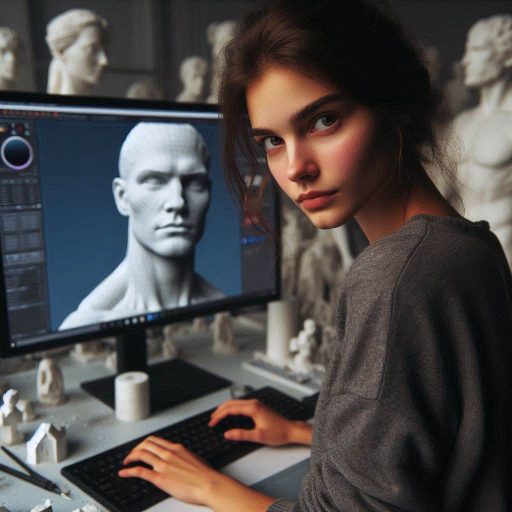Introduction
Staying updated on art and design trends is crucial in the ever-evolving creative industry.
Trends play a significant role in influencing consumer preferences and setting industry standards.
In 2024, several exciting trends are set to dominate the art and design landscape.
Art
Abstract art continues to be a popular choice for both artists and collectors in 2024.
The use of bold colors and geometric shapes will be prevalent in many pieces.
Sustainability will also be a key focus, with artists incorporating eco-friendly materials into their work.
Additionally, the rise of NFTs (non-fungible tokens) will revolutionize the way art is bought and sold, offering new opportunities for artists to showcase their work and reach a wider audience.
Design
In the realm of design, minimalism will remain a dominant trend in 2024.
Clean lines, simple typography, and a focus on negative space will be key elements in creating sleek and modern designs.
With the growing importance of user experience, designers will prioritize creating intuitive and user-friendly interfaces across various platforms.
Augmented reality and virtual reality will also play a significant role in design, offering new possibilities for immersive and interactive experiences.
As we look ahead to 2024, it is clear that the art and design landscape will continue to evolve in exciting ways.
By staying informed and embracing these trends, artists and designers can stay ahead of the curve and create innovative and impactful work.
Sustainability in Design
As the world continues to prioritize environmental conservation, sustainable design practices are gaining more attention in the art and design industry.
Increasing Focus on Eco-Friendly Design Practices
In 2024, it is expected that the focus on eco-friendly design practices will only intensify.
Artists and designers embrace sustainability in their work.
They respond to climate change and environmental issues.
Global awareness of these issues rises daily.
This shift leads to innovative and meaningful creations.
Sustainable practices influence design choices and artistic expression.
Transform Your Career Today
Unlock a personalized career strategy that drives real results. Get tailored advice and a roadmap designed just for you.
Start NowCreatives actively seek eco-friendly materials and methods.
Their work reflects a commitment to a healthier planet.
Examples of Sustainable Materials and Techniques
Designers are experimenting with a variety of sustainable materials such as recycled plastics, bamboo, cork, and organic cotton.
These materials not only reduce the environmental impact of art and design projects but also add unique textures and aesthetics to the final creations.
Techniques like upcycling and repurposing old materials into new pieces of art are also gaining popularity.
This trend not only reduces waste but also adds a touch of creativity and innovation to the design process.
Prediction for 2024
Looking ahead to 2024, sustainability is expected to be a major driving force in the art and design industry.
Consumers increasingly prioritize eco-friendly purchases.
Artists and designers must adapt to this trend.
They should incorporate sustainable practices into their work.
This change benefits both the environment and their brand.
Embracing eco-friendly methods attracts conscious consumers.
Sustainability in design represents a vital shift.
It fosters an environmentally conscious art community.
Designers embrace responsible practices daily.
This approach impacts materials and methods used.
Artists prioritize eco-friendly choices in their work.
Sustainability guides the future of design. This trend shapes a better tomorrow for all.
Read: Art and Design Careers: What You Need to Know
Virtual and Augmented Reality
Virtual Reality (VR) and Augmented Reality (AR) technology are quickly revolutionizing the art and design industries.
Artists and designers are now able to create immersive experiences that were once unimaginable.
How VR and AR Technology are Revolutionizing the Art and Design Industries
VR allows artists to create entire worlds that viewers can explore and interact with.
AR overlays digital elements onto the real world, blending the physical and digital realms seamlessly.
Artists and designers can use VR and AR tools to experiment with new forms of expression and push the boundaries of traditional art forms.
Examples of How Artists and Designers are Incorporating Virtual Elements into Their Work
Some artists are using VR to create fully immersive installations that transport viewers to different environments.
Designers are incorporating AR into their work to offer interactive experiences to clients, such as virtual room previews or product simulations.
VR is being used in art therapy to help patients explore their emotions and express themselves in a safe and creative environment.
Prediction on the Growing Popularity of VR and AR in 2024
In 2024, VR and AR technology will gain popularity.
Artists will embrace these technologies for innovative creations.
Designers will integrate VR and AR into their workflows.
Companies will invest in immersive experiences for clients.
Audiences will experience art in entirely new ways.
Technology evolves and becomes more accessible.
Artists and designers embrace virtual elements.
They discover innovative ways to integrate these elements into their work.
New tools inspire creative possibilities and enhance artistic expression.
Read: Must-Visit Glass Art Studios in America
Minimalism and Clean Designs
In recent years, minimalism has become a dominant trend in the art and design world.
This aesthetic focuses on simplicity, clean lines, and a clutter-free approach to design.
As we look ahead to 2024, it is clear that minimalism will continue to be a popular choice for both artists and designers.
The rise of minimalism and clean designs in art and design
The rise of minimalism can be attributed to a variety of factors.
In a world that is increasingly chaotic and fast-paced, many people are drawn to the calming influence of minimalist design.
Minimalism conveys sophistication and elegance.
Many choose it for timeless aesthetics.
Examples of minimalist trends in graphic design, fashion, and home decor
- Graphic Design: Minimalist graphic design often features clean typography, ample white space, and simple color palettes.
Brands such as Apple and Google have embraced minimalist design in their branding and marketing materials. - Fashion: In the world of fashion, minimalist trends can be seen in the rise of capsule wardrobes, monochromatic color schemes, and sleek silhouettes.
Designers like Celine and The Row are known for their minimalist approach to fashion. - Home Decor: Minimalist home decor focuses on decluttering and simplifying living spaces.
Scandinavian design, with its emphasis on clean lines and natural materials, is a popular choice for those seeking a minimalist aesthetic in their homes.
Prediction on the continued popularity of minimalism in 2024
As we look ahead to 2024, it is clear that minimalism will continue to be a dominant trend in the art and design world.
Its timeless appeal, calming influence, and sophisticated aesthetic make it a popular choice for artists, designers, and consumers alike.
Whether you are drawn to minimalist graphic design, fashion, or home decor, it is clear that minimalism is here to stay.
Read: Top Art and Design Schools in the USA for Sculptors

Bold Colors and Abstract Patterns
The use of bold colors and abstract patterns in art and design
Exploring the use of bold colors and abstract patterns in art and design is a significant trend in 2024.
Designers are increasingly incorporating vibrant hues and unconventional patterns to make their creations stand out.
This trend is expected to continue gaining popularity in the upcoming year.
Examples of Bold Colors and Abstract Patterns in Design
Graphic designers are using neon colors and geometric patterns in digital art.
Fashion designers are experimenting with bold prints and abstract motifs in their collections.
Interior designers are incorporating vibrant wallpaper and eclectic patterns in their projects.
Predictions for the Trend of Bold Colors and Abstract Patterns in 2024
Bold colors and abstract patterns dominate fashion today.
Interior design embraces these vibrant trends as well.
Graphic design showcases exciting uses of these elements.
Various industries actively adopt this colorful approach.
Consumers are increasingly drawn to unique and eye-catching designs that incorporate bold colors and abstract patterns.
Brands use bold colors and abstract patterns. They aim to attract a younger audience.
These visuals appeal to a more visually-oriented crowd.
Read: Becoming a Sculptor: Skills, Tools, and Training
Discover More: Marketing Strategies for Sign Making Services
Cultural Diversity and Inclusivity
Importance of cultural diversity and inclusivity in art and design
Discussion on the importance of cultural diversity and inclusivity in art and design is a crucial aspect of the creative industry.
Recognizing and embracing different cultural perspectives and identities enriches the artistic landscape and promotes a more inclusive society.
Examples of artists and designers embracing diverse perspectives and identities
Artists and designers actively seek diverse perspectives.
They promote cultural understanding through their work.
Their efforts foster unity among different identities.
Embracing diversity enriches artistic expression and creativity.
Each voice contributes to a broader cultural narrative.
Their collaboration encourages deeper connections among communities.
For example, artists like Yinka Shonibare, who explores issues of colonialism and globalization, bring attention to underrepresented voices and narratives.
Designers like Karim Rashid embrace eclectic, multicultural designs.
They push the boundaries of traditional aesthetics.
Rashid incorporates elements from diverse cultural backgrounds.
His work showcases unique combinations of style and form.
By incorporating diverse influences, these creators challenge conventional norms and redefine the standards of beauty and creativity.
Prediction on the continued emphasis on cultural diversity and inclusivity in 2024
In 2024, society will emphasize cultural diversity.
Awareness of representation grows each day.
People recognize the importance of equality everywhere.
This focus will impact all life aspects. Inclusivity will shape our communities and workplaces.
The increasing demand for diverse and inclusive art and design signifies a shift towards a more inclusive and equitable future.
DIY and Personalization
One of the most prominent trends in art and design for 2024 is the rise of do-it-yourself (DIY) and personalization.
This trend has been gaining momentum in recent years, with more and more consumers looking for ways to express their individuality and create unique pieces that reflect their personality.
The growing trend of DIY and personalization in art and design
DIY and personalization allow individuals to break away from mass-produced items and instead, create something that is uniquely their own.
It gives people the opportunity to showcase their creativity and craft skills, as well as to add a personal touch to their living spaces.
Examples of how consumers are seeking unique and customized products
- Customized clothing and accessories: Consumers are increasingly turning to customized clothing and accessories to stand out from the crowd.
From personalized t-shirts to bespoke handbags, people are looking for ways to express their individual style. - DIY home decor: Many individuals are opting to create their own home decor items, such as custom-made furniture, one-of-a-kind art pieces, and handmade knick-knacks.
This allows them to infuse their living spaces with personality and charm. - Personalized gifts: Instead of opting for generic gifts, consumers are now choosing to give personalized items that are meaningful and thoughtful.
From customized jewelry to handcrafted photo albums, people are seeking out gifts that are as unique as the recipient.
Prediction on the increasing demand for DIY and personalized items in 2024
As we look ahead to 2024, it is clear that the demand for DIY and personalized items will continue to grow.
Consumers are increasingly valuing individuality and self-expression, and are willing to invest time and effort into creating or customizing products that reflect their personal taste.
In a nutshell, DIY and personalization are set to be major trends in art and design in 2024.
With a focus on creativity, uniqueness, and self-expression, this trend is driven by consumers who are seeking to break away from the norm and create pieces that are truly one-of-a-kind.
Conclusion
In 2024, art and design trends are expected to be bold and innovative, embracing new technologies and sustainable practices.
Minimalism, maximalism, and ethereal designs will continue to dominate the industry.
As we look ahead to the coming year, it’s important for creators to stay informed and adapt to emerging trends.
Embracing change and experimentation will lead to fresh and exciting work.
The art and design industries are constantly evolving, pushing boundaries and challenging norms.
By staying open-minded and creative, artists and designers can continue to make a positive impact on the world.




